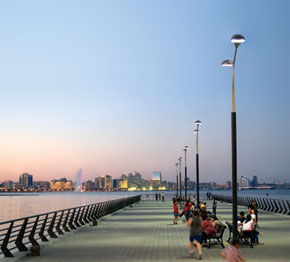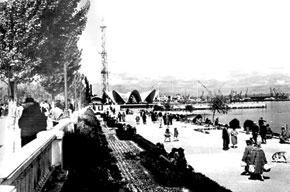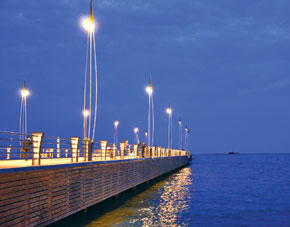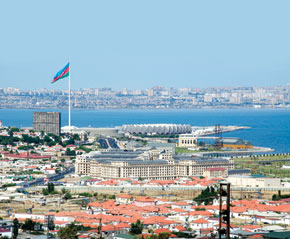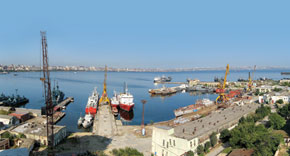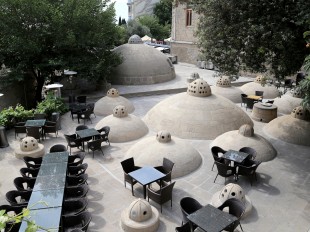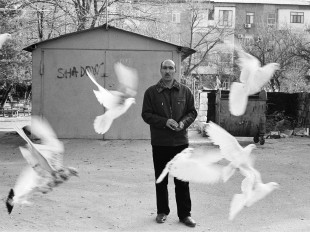Baku’s much-loved ‘Bulvar’ has been central to city life for well over a hundred years. Originally occupying just a few hundred metres from today’s Puppet Theatre to Azneft Square, the historic Boulevard has gradually lengthened and in early June 2015 witnessed its most dramatic expansion to date, with the newly unveiled Baku White City and Bayil Boulevards stretching several kilometres further east and west. To mark the event, Camilla Rzayeva shares her memories of the Boulevard and growing up near today’s Flag Square.
I always thought that documenting things, in photographs or notes, was a very important way of keeping them alive, at least in memories. In a way, things that we want to remember attain some form of immortality in the images that we choose to capture. People as well as places may change appearances to the point of being completely unrecognisable; some may even no longer be there 10 years down the road.
Growing up in an apartment building located about 200 metres from the Bulvar (Seaside Boulevard – Ed.) meant living by the sea, with all the subsequent perks. And by perks I mean beautiful sunrises and sunsets, holiday fireworks from the Boulevard and the ability to enjoy the sea breeze, which creates a very special air in the evening. Air that smells like the sea - this is one of the most common memories shared by those living near the Boulevard. As hard as it may be to see places dear to one’s heart disappear, it is important to realise that sometimes by letting go of the old memories, we allow ourselves to generate new ones. Looking through my gallery of pictures and seeing the western end of the Boulevard as it used to be certainly brings fond memories, but I think the development of the new Boulevard has brought many benefits too.
It wasn’t just a small area of land that was subject to change. Looking at the newly enlarged Boulevard, spreading almost all the way around the Baku Bay from Bibi Heybat in the west to the White City (formerly the Black City – Ed.) in the east is quite astonishing. I remember driving past the Bibi Heybat district where there was nothing but oil rigs. Most were inactive, but they presented a very characteristic scene which photographers adored, and this area was often a popular choice for magazine cover shots and movie scenes. Those oil rigs also signified how Baku first gained its significance in the mid-nineteenth century through the rapid development of its oil industry. Now they have disappeared into the city’s history, but I’m sure the brand new collection of walkways, parkland, restaurants, galleries and arenas of the new Boulevard will attract ever more pointed lenses and keen walkers.
Previously, there was no access to the sea beyond Flag Square like there is now. Since much of the new Boulevard used to be a naval base civilians could only access it with special permission. As a child I used to go there a lot, since both my parents and my grandmother were in active service. There was an old kindergarten adjacent to the naval base, which used to be specifically for children of those that served there. We would occasionally go there as part of a walk and with special permission we were allowed to play in the sea. Otherwise there was no public access. But today, the clearing of the area around Flag Square and further west towards Bibi Heybat, and its opening to the Caspian Sea, add to the growing list of attractions for both Azerbaijanis and the increasing number of tourists visiting Baku every year.
During its construction, I documented with fascination every new addition being made to Flag Square. The rooftop of our apartment building became my watchtower and it felt like I was recording history. I really do believe it was a historically important moment in the development of the Azerbaijani capital. After a long period of stagnation, it seemed Baku was finally paving its way to being recognized as the most developed Muslim country of the 21st century. It was the same year too (2012) that the Flame Towers and other prominent buildings and resorts in and around Baku were popping up.
I haven’t lived in Baku for several years, and it may seem that my opinions are too subjective. But I was among those who had to move from the neighbourhood in Bayil I called home for 23 years due to construction works on the western end of the Boulevard, because I believe that beautiful places like this need to be built and shared amongst the wider public. Previously, the old navy base and the adjacent lands of Bayil were secluded locations, full of beauty but only enjoyed by a small number of people.
More developments may also be on the way. With the first European Games which has just taken place in Baku, more and more people are showing an interest in various sports. Social networks provide one of the best indicators of what young people are interested in, and the number of posts dedicated to various workouts and gym sessions are increasing. In particular, yoga and pilates have been gaining popularity among Azerbaijani women recently and, as is often the case abroad, these activities may gradually move outdoors. What better area to practise than the newly extended Boulevard?
When I look closely at the transformation of the Baku bay throughout the years, it seems as though the Boulevard expands in proportion with Baku’s development in general. It’s hard to imagine that the original Boulevard used to be just a few kilometres long and was in many ways under-developed. For me, going out to the Boulevard used to mean walking to the Baku Venetia (Little Venice – Ed.), which is a formation of three parallel waterways connected by small bridges. As with the rest of the Boulevard, it used to look much different back then, but the essence of it still prevails. There was also a line of Soviet-era Ferris wheels and attractions; the only one that remains now is the Devil’s Wheel by the Puppet Theatre.
It is beautiful that in the process of reconstruction the very nature of the Boulevard has stayed intact, only its presentation now is more sophisticated. I often wonder how people who haven’t lived in Baku for many years would orientate themselves here if they ever came back. One of the replies I received recently was: eventually, easily. A family friend, an Azerbaijani who hasn’t seen Baku since 1986, also said: it’s essentially our good old Baku, just a tad “upgraded.”
It’s uplifting to see Baku grow and bloom so rapidly. It seems as though time passes a bit faster now and so it’s understandable why previous generations are so reluctant to let go of the past, since otherwise it might seem that it never existed at all. But instead of letting our attachment to the past destabilise the present, I think it is more prudent to keep our memories in photographs, proudly displayed on the shelves of our new life.
I always thought that documenting things, in photographs or notes, was a very important way of keeping them alive, at least in memories. In a way, things that we want to remember attain some form of immortality in the images that we choose to capture. People as well as places may change appearances to the point of being completely unrecognisable; some may even no longer be there 10 years down the road.
Growing up in an apartment building located about 200 metres from the Bulvar (Seaside Boulevard – Ed.) meant living by the sea, with all the subsequent perks. And by perks I mean beautiful sunrises and sunsets, holiday fireworks from the Boulevard and the ability to enjoy the sea breeze, which creates a very special air in the evening. Air that smells like the sea - this is one of the most common memories shared by those living near the Boulevard. As hard as it may be to see places dear to one’s heart disappear, it is important to realise that sometimes by letting go of the old memories, we allow ourselves to generate new ones. Looking through my gallery of pictures and seeing the western end of the Boulevard as it used to be certainly brings fond memories, but I think the development of the new Boulevard has brought many benefits too.
It wasn’t just a small area of land that was subject to change. Looking at the newly enlarged Boulevard, spreading almost all the way around the Baku Bay from Bibi Heybat in the west to the White City (formerly the Black City – Ed.) in the east is quite astonishing. I remember driving past the Bibi Heybat district where there was nothing but oil rigs. Most were inactive, but they presented a very characteristic scene which photographers adored, and this area was often a popular choice for magazine cover shots and movie scenes. Those oil rigs also signified how Baku first gained its significance in the mid-nineteenth century through the rapid development of its oil industry. Now they have disappeared into the city’s history, but I’m sure the brand new collection of walkways, parkland, restaurants, galleries and arenas of the new Boulevard will attract ever more pointed lenses and keen walkers.
Previously, there was no access to the sea beyond Flag Square like there is now. Since much of the new Boulevard used to be a naval base civilians could only access it with special permission. As a child I used to go there a lot, since both my parents and my grandmother were in active service. There was an old kindergarten adjacent to the naval base, which used to be specifically for children of those that served there. We would occasionally go there as part of a walk and with special permission we were allowed to play in the sea. Otherwise there was no public access. But today, the clearing of the area around Flag Square and further west towards Bibi Heybat, and its opening to the Caspian Sea, add to the growing list of attractions for both Azerbaijanis and the increasing number of tourists visiting Baku every year.
During its construction, I documented with fascination every new addition being made to Flag Square. The rooftop of our apartment building became my watchtower and it felt like I was recording history. I really do believe it was a historically important moment in the development of the Azerbaijani capital. After a long period of stagnation, it seemed Baku was finally paving its way to being recognized as the most developed Muslim country of the 21st century. It was the same year too (2012) that the Flame Towers and other prominent buildings and resorts in and around Baku were popping up.
I haven’t lived in Baku for several years, and it may seem that my opinions are too subjective. But I was among those who had to move from the neighbourhood in Bayil I called home for 23 years due to construction works on the western end of the Boulevard, because I believe that beautiful places like this need to be built and shared amongst the wider public. Previously, the old navy base and the adjacent lands of Bayil were secluded locations, full of beauty but only enjoyed by a small number of people.
More developments may also be on the way. With the first European Games which has just taken place in Baku, more and more people are showing an interest in various sports. Social networks provide one of the best indicators of what young people are interested in, and the number of posts dedicated to various workouts and gym sessions are increasing. In particular, yoga and pilates have been gaining popularity among Azerbaijani women recently and, as is often the case abroad, these activities may gradually move outdoors. What better area to practise than the newly extended Boulevard?
When I look closely at the transformation of the Baku bay throughout the years, it seems as though the Boulevard expands in proportion with Baku’s development in general. It’s hard to imagine that the original Boulevard used to be just a few kilometres long and was in many ways under-developed. For me, going out to the Boulevard used to mean walking to the Baku Venetia (Little Venice – Ed.), which is a formation of three parallel waterways connected by small bridges. As with the rest of the Boulevard, it used to look much different back then, but the essence of it still prevails. There was also a line of Soviet-era Ferris wheels and attractions; the only one that remains now is the Devil’s Wheel by the Puppet Theatre.
It is beautiful that in the process of reconstruction the very nature of the Boulevard has stayed intact, only its presentation now is more sophisticated. I often wonder how people who haven’t lived in Baku for many years would orientate themselves here if they ever came back. One of the replies I received recently was: eventually, easily. A family friend, an Azerbaijani who hasn’t seen Baku since 1986, also said: it’s essentially our good old Baku, just a tad “upgraded.”
It’s uplifting to see Baku grow and bloom so rapidly. It seems as though time passes a bit faster now and so it’s understandable why previous generations are so reluctant to let go of the past, since otherwise it might seem that it never existed at all. But instead of letting our attachment to the past destabilise the present, I think it is more prudent to keep our memories in photographs, proudly displayed on the shelves of our new life.
